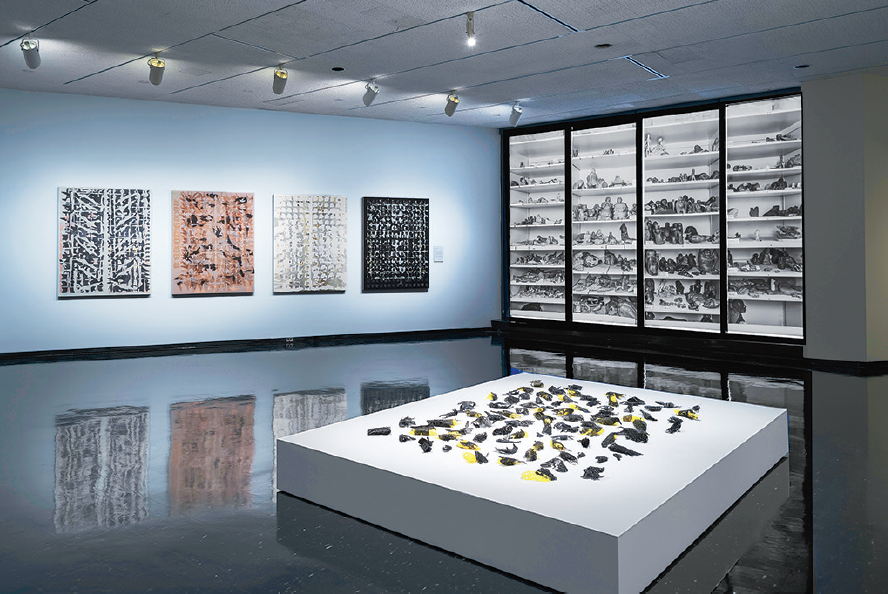Looking Up: Contemporary Connections with Inuit Art
Winnipeg has a cool contemporary art scene. It is also home to the world’s largest public collection of Inuit art, which is held by the Winnipeg Art Gallery and numbers almost 13,000 works. A current group show put together by the WAG’s new curator of contemporary art, artist Paul Butler, shows more than coincidence at work here. “Looking Up: Contemporary Connections with Inuit Art” starts with eight Winnipeggers who have acknowledged a northern influence in their art. Each was asked to create new work in response to work by Inuit artists and to choose pieces from the WAG vaults to exhibit alongside their own. According to Butler, the results demonstrate “a connection between two communities with an idiosyncratic history, who mythologize, share stories, tell jokes and capture their landscape through the common language of art.”
The question of influence is important but also elusive. Looking Up avoids overdetermined equations, instead suggesting intriguing overlaps between artists in Winnipeg and the scene farther north. Just as importantly, the show gives equal space and equal heft to both groups.

Installation view “Looking Up: Contemporary Connections With Inuit Art,” 2014. Photographs: Ernest Mayer, Winnipeg Art Gallery.
Sometimes the northern connection comes out in subject matter. Simon Hughes, who has shown before with Inuit artists such as Shuvinai Ashoona, Tim Pitsiulak and Qavavau Manumie, creates imagined worlds that combine modernist structures with polar wilderness. Sometimes, as in Two Solitudes, he deploys a deadpan assortment of Canadian stereotypes, building up a kind of quirky Canuck utopia (or dystopia, going by the shopping mall skywalk). In Fractured Monochrome #4, he mixes an arctic attention to the specific qualities of ice, cold and light with the hard-edged geometry of post-painterly abstraction.
Jeanette Johns has created a long 12-panel etching that wraps around the corner of one gallery. An artist who often references systems for representing the landscape, Johns is drawn to the mathematics and geometry of graphs, diagrams and maps. A View of the Infinite North starts off looking like an exquisite perspective drawing, a rational exercise in vanishing points and orthogonal lines, but it builds to an ineffable experience of an endless arctic horizon lit by the aurora borealis.
For Aganetha Dyck, the connection to Inuit art comes primarily through medium. As an artist who has experimented with textiles for decades, she is inspired by women like Jessie Oonark, who grew up sewing for survival and later transferred that skill to tapestries, sometimes on a monumental scale. Dyck’s sculptural felted-wool shapes, Untitled (Shrinks), with their suggestion of wayward organic growth, are comic, unexpected, maybe even a bit threatening.

John Pangnark, Man, c. 1968, stone. Canadian (Arviat), 1920–1980. Collection of the Winnipeg Art Gallery. Twomey Collection, with appreciation to the Province of Manitoba and Government of Canada.
Michael Dumontier, a founding member of Winnipeg’s influential Royal Art Lodge, offers deceptively simple works that are both lucid and mysterious, concrete and conceptual. A knife seems to have cut itself out of a plywood board; what seem to be fragile eggs are actually solid amalgams of MDF and acrylic paint. Dumontier pairs his work with the small, pared-down forms of Andy Miki and John Pangnark, which possess a similar hold-in-your-hand modesty.
Neil Farber, another Royal Art Lodger, seems to find northern parallels in his artistic process. Red Giant is a massive ink-onpaper work packed with detailed miniature forms. Its quality of magnificent obsession calls up the time-consuming, inward-looking working method you often get with artists who are inside for long, cold winters.
This kind of patience also shows up in the work of Paul Robles. In Untitled (Homecoming), a low dais is covered with the fragile forms of dozens of birds. From a distance, it looks like a massive die-off, some unspecified environmental disaster. Up close, the birds are revealed as elaborately artful cut-paper shapes. It’s a discomfiting collision of nature and culture.

Michael Dumontier, Untitled, 2013, paper, MDF, coloured pencil, 20.8 x 27.9 x 1.9 cm. Collection of the artist.
The northern artists on view don’t demonstrate clear oneto- one correspondences with the eight Winnipeg artists. And that’s actually a good thing. Looking Up is not using Inuit art as some means to an end (in the way that early modernists used “exotic” and “primitive” art to break out of the cage of Western civilization, for example). Nancy Pukingrnak Aupaluktuq’s witty repetition, Pudlo Pudlat’s matterof- fact magic, Nick Sikkuark’s half-horrifying, half-humorous transformations all stand on their own, drawing on Inuit art’s specific history but also demonstrating its varied and vital currency. It’s significant that Luke Anguhadluk, who was born in 1895 and lived on the land for most of his life, seems to emerge as a presiding spirit over the contemporary scene, his work being cited by several artists. While Anguhadluk’s work deals with the traditional subjects of the hunter and the hunted, his rough-andready reductionism feels strikingly modern.
The Winnipeg Art Gallery’s new purpose-built Inuit Art and Learning Centre, designed by American architect Michael Maltzan, is scheduled to break ground later this year. This show suggests the ways in which the WAG’s Inuit collection has always been part of an ongoing cultural exchange. ❚
“Looking Up: Contemporary Connections with Inuit Art” was exhibited at the Winnipeg Art Gallery from December 20, 2013 to March 6, 2014.
Alison Gillmor is the pop culture columnist for the Winnipeg Free Press and writes regularly on visual arts and film.

